Kaplan Psychology: Serial Position Effect in Short-term Memory Report
VerifiedAdded on 2023/01/17
|15
|3114
|28
Report
AI Summary
This psychology lab report investigates the serial position effect, a cognitive phenomenon where the position of an item in a list influences its recall. The study involved eleven participants who were presented with four lists of twelve words each. The experiment aimed to replicate past findings that items at the beginning (primacy effect) and end (recency effect) of the lists are recalled more frequently than those in the middle. The report includes an introduction, literature review discussing relevant theories like the Atkinson and Shiffrin model, methodology detailing the experimental procedure, and a results section with tables and graphs illustrating the frequency of recalled words at different positions. The analysis reveals that the results align with the serial position effect, demonstrating the primacy and recency trends. The discussion interprets these findings, supporting the hypothesis that items at the beginning and end of a list are more easily remembered due to factors such as rehearsal and short-term memory capacity.

Running head: THE SERIAL POSITION EFFECT 1
The Serial Position Effect in Short-term Memory
Student’s Name
Institutional Affiliation
Date
Abstract
The Serial Position Effect in Short-term Memory
Student’s Name
Institutional Affiliation
Date
Abstract
Paraphrase This Document
Need a fresh take? Get an instant paraphrase of this document with our AI Paraphraser
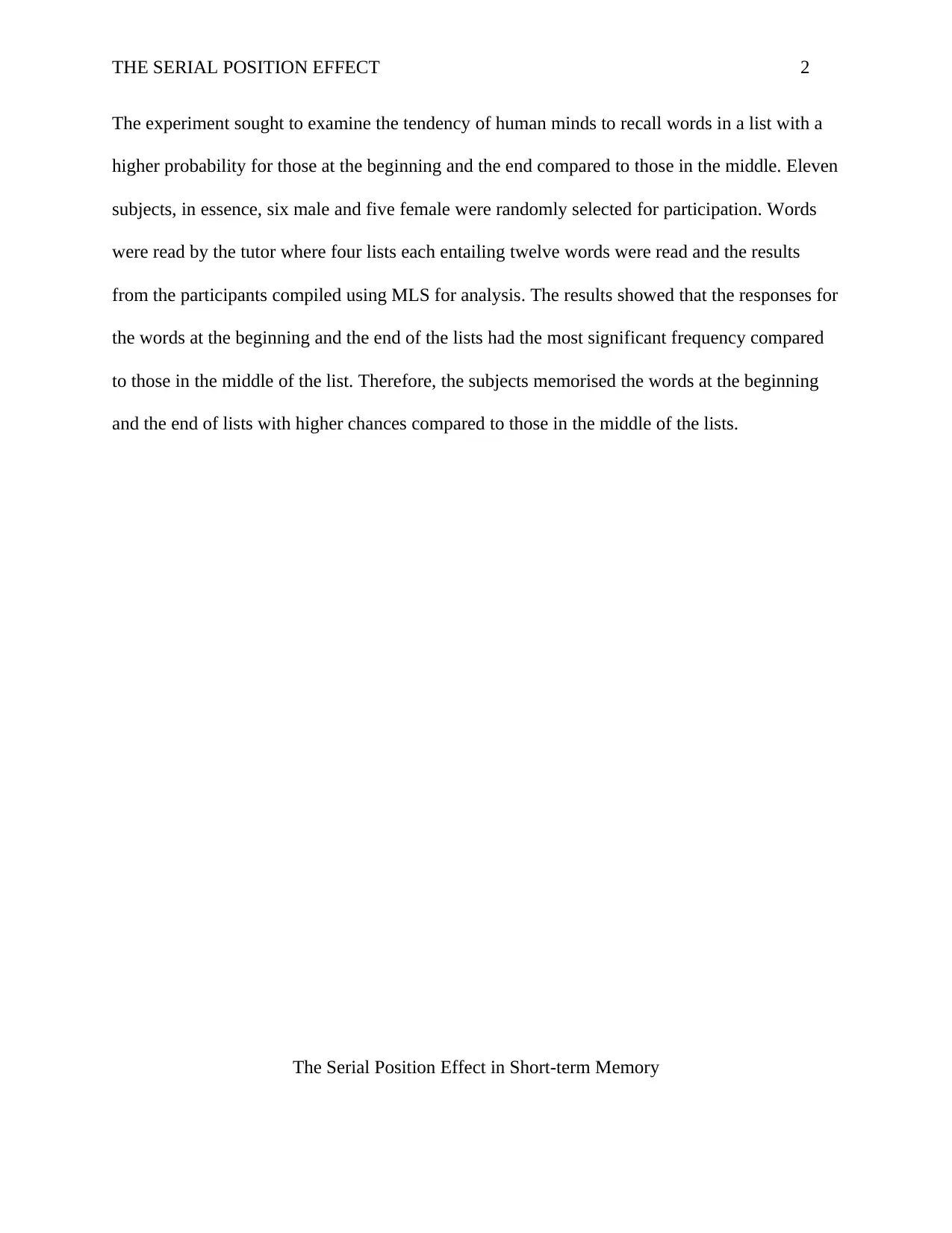
THE SERIAL POSITION EFFECT 2
The experiment sought to examine the tendency of human minds to recall words in a list with a
higher probability for those at the beginning and the end compared to those in the middle. Eleven
subjects, in essence, six male and five female were randomly selected for participation. Words
were read by the tutor where four lists each entailing twelve words were read and the results
from the participants compiled using MLS for analysis. The results showed that the responses for
the words at the beginning and the end of the lists had the most significant frequency compared
to those in the middle of the list. Therefore, the subjects memorised the words at the beginning
and the end of lists with higher chances compared to those in the middle of the lists.
The Serial Position Effect in Short-term Memory
The experiment sought to examine the tendency of human minds to recall words in a list with a
higher probability for those at the beginning and the end compared to those in the middle. Eleven
subjects, in essence, six male and five female were randomly selected for participation. Words
were read by the tutor where four lists each entailing twelve words were read and the results
from the participants compiled using MLS for analysis. The results showed that the responses for
the words at the beginning and the end of the lists had the most significant frequency compared
to those in the middle of the list. Therefore, the subjects memorised the words at the beginning
and the end of lists with higher chances compared to those in the middle of the lists.
The Serial Position Effect in Short-term Memory

THE SERIAL POSITION EFFECT 3
Introduction
The serial position effect in psychology seeks to explain the tendency of the human brain
to recall the first and last items compared to the items at the middles of a given list (Yang et al.,
2019). The author explained the serial effect involves two primary concepts, in essence, the
primacy and the recency effects. The primacy and the recency concepts depict how the items at
the beginning of a sequence and the end are likely to be recalled with higher accuracy than those
at the middle of the list (Allen, Hitch, & Baddeley, 2018). Therefore, the report presented a list
of items that was memorised to examine the effects of serial position.
Purpose of study
The study aims to evaluate the serial position effect without manipulation of the subjects
towards memorising. This would be tested through the number of words recalled in a list of
given words read to the subjects.
Hypothesis
Null Hypothesis, H0: Items at the beginning and the end of a list are likely to be recalled with
higher accuracy as opposed to those at the middle.
Alternative Hypothesis, H1: Items at the beginning and the end of a list are not likely to be
recalled with higher accuracy as opposed to those at the middle.
Justification of hypothesis
The selected hypothesis would incline the experiment towards the topic of study, serial
position effect thus making the researcher draw significant judgments from the literature review/
background information, findings/ results, and from the analysis and discussion at the end of the
experiment.
Literature review
Introduction
The serial position effect in psychology seeks to explain the tendency of the human brain
to recall the first and last items compared to the items at the middles of a given list (Yang et al.,
2019). The author explained the serial effect involves two primary concepts, in essence, the
primacy and the recency effects. The primacy and the recency concepts depict how the items at
the beginning of a sequence and the end are likely to be recalled with higher accuracy than those
at the middle of the list (Allen, Hitch, & Baddeley, 2018). Therefore, the report presented a list
of items that was memorised to examine the effects of serial position.
Purpose of study
The study aims to evaluate the serial position effect without manipulation of the subjects
towards memorising. This would be tested through the number of words recalled in a list of
given words read to the subjects.
Hypothesis
Null Hypothesis, H0: Items at the beginning and the end of a list are likely to be recalled with
higher accuracy as opposed to those at the middle.
Alternative Hypothesis, H1: Items at the beginning and the end of a list are not likely to be
recalled with higher accuracy as opposed to those at the middle.
Justification of hypothesis
The selected hypothesis would incline the experiment towards the topic of study, serial
position effect thus making the researcher draw significant judgments from the literature review/
background information, findings/ results, and from the analysis and discussion at the end of the
experiment.
Literature review
⊘ This is a preview!⊘
Do you want full access?
Subscribe today to unlock all pages.

Trusted by 1+ million students worldwide
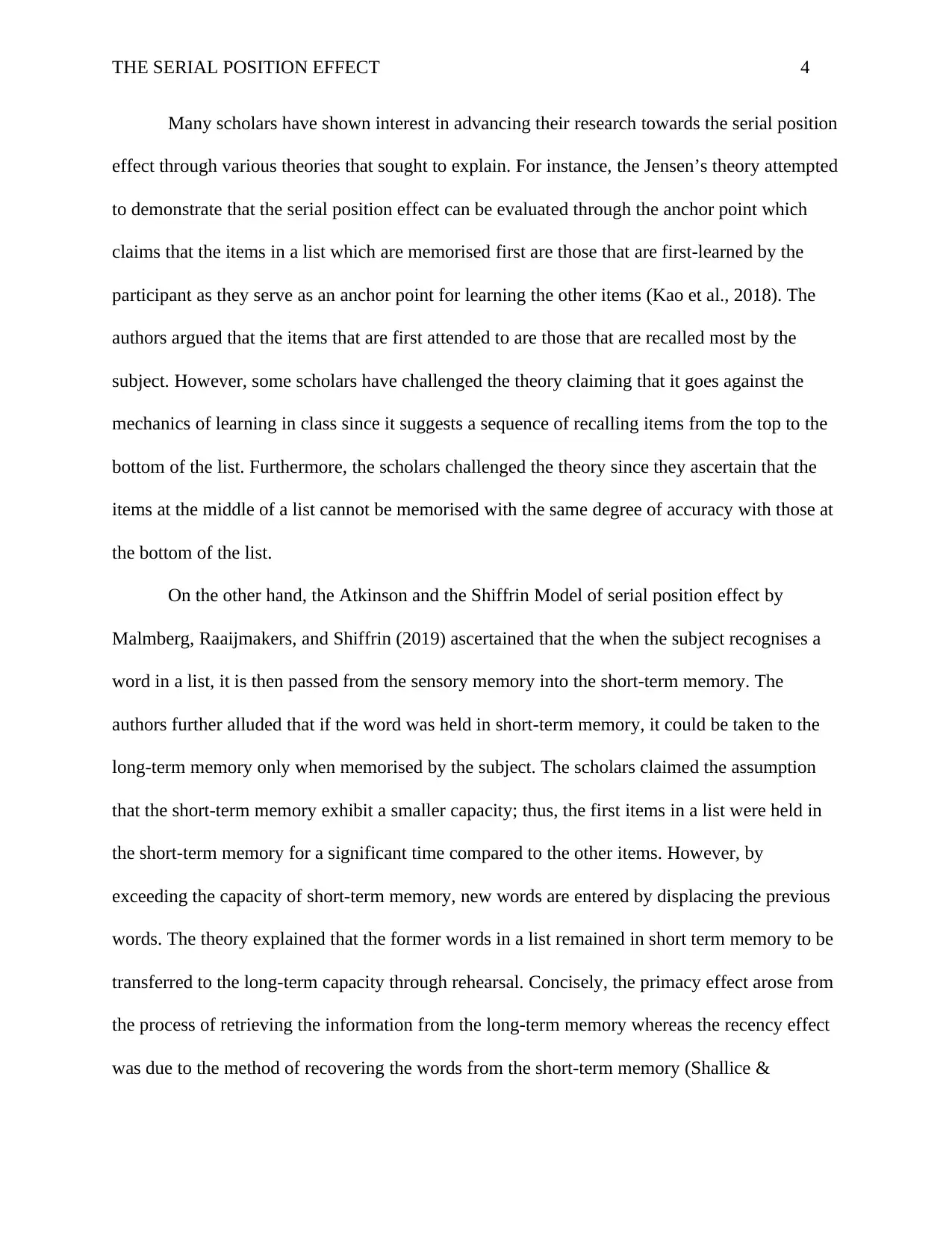
THE SERIAL POSITION EFFECT 4
Many scholars have shown interest in advancing their research towards the serial position
effect through various theories that sought to explain. For instance, the Jensen’s theory attempted
to demonstrate that the serial position effect can be evaluated through the anchor point which
claims that the items in a list which are memorised first are those that are first-learned by the
participant as they serve as an anchor point for learning the other items (Kao et al., 2018). The
authors argued that the items that are first attended to are those that are recalled most by the
subject. However, some scholars have challenged the theory claiming that it goes against the
mechanics of learning in class since it suggests a sequence of recalling items from the top to the
bottom of the list. Furthermore, the scholars challenged the theory since they ascertain that the
items at the middle of a list cannot be memorised with the same degree of accuracy with those at
the bottom of the list.
On the other hand, the Atkinson and the Shiffrin Model of serial position effect by
Malmberg, Raaijmakers, and Shiffrin (2019) ascertained that the when the subject recognises a
word in a list, it is then passed from the sensory memory into the short-term memory. The
authors further alluded that if the word was held in short-term memory, it could be taken to the
long-term memory only when memorised by the subject. The scholars claimed the assumption
that the short-term memory exhibit a smaller capacity; thus, the first items in a list were held in
the short-term memory for a significant time compared to the other items. However, by
exceeding the capacity of short-term memory, new words are entered by displacing the previous
words. The theory explained that the former words in a list remained in short term memory to be
transferred to the long-term capacity through rehearsal. Concisely, the primacy effect arose from
the process of retrieving the information from the long-term memory whereas the recency effect
was due to the method of recovering the words from the short-term memory (Shallice &
Many scholars have shown interest in advancing their research towards the serial position
effect through various theories that sought to explain. For instance, the Jensen’s theory attempted
to demonstrate that the serial position effect can be evaluated through the anchor point which
claims that the items in a list which are memorised first are those that are first-learned by the
participant as they serve as an anchor point for learning the other items (Kao et al., 2018). The
authors argued that the items that are first attended to are those that are recalled most by the
subject. However, some scholars have challenged the theory claiming that it goes against the
mechanics of learning in class since it suggests a sequence of recalling items from the top to the
bottom of the list. Furthermore, the scholars challenged the theory since they ascertain that the
items at the middle of a list cannot be memorised with the same degree of accuracy with those at
the bottom of the list.
On the other hand, the Atkinson and the Shiffrin Model of serial position effect by
Malmberg, Raaijmakers, and Shiffrin (2019) ascertained that the when the subject recognises a
word in a list, it is then passed from the sensory memory into the short-term memory. The
authors further alluded that if the word was held in short-term memory, it could be taken to the
long-term memory only when memorised by the subject. The scholars claimed the assumption
that the short-term memory exhibit a smaller capacity; thus, the first items in a list were held in
the short-term memory for a significant time compared to the other items. However, by
exceeding the capacity of short-term memory, new words are entered by displacing the previous
words. The theory explained that the former words in a list remained in short term memory to be
transferred to the long-term capacity through rehearsal. Concisely, the primacy effect arose from
the process of retrieving the information from the long-term memory whereas the recency effect
was due to the method of recovering the words from the short-term memory (Shallice &
Paraphrase This Document
Need a fresh take? Get an instant paraphrase of this document with our AI Paraphraser
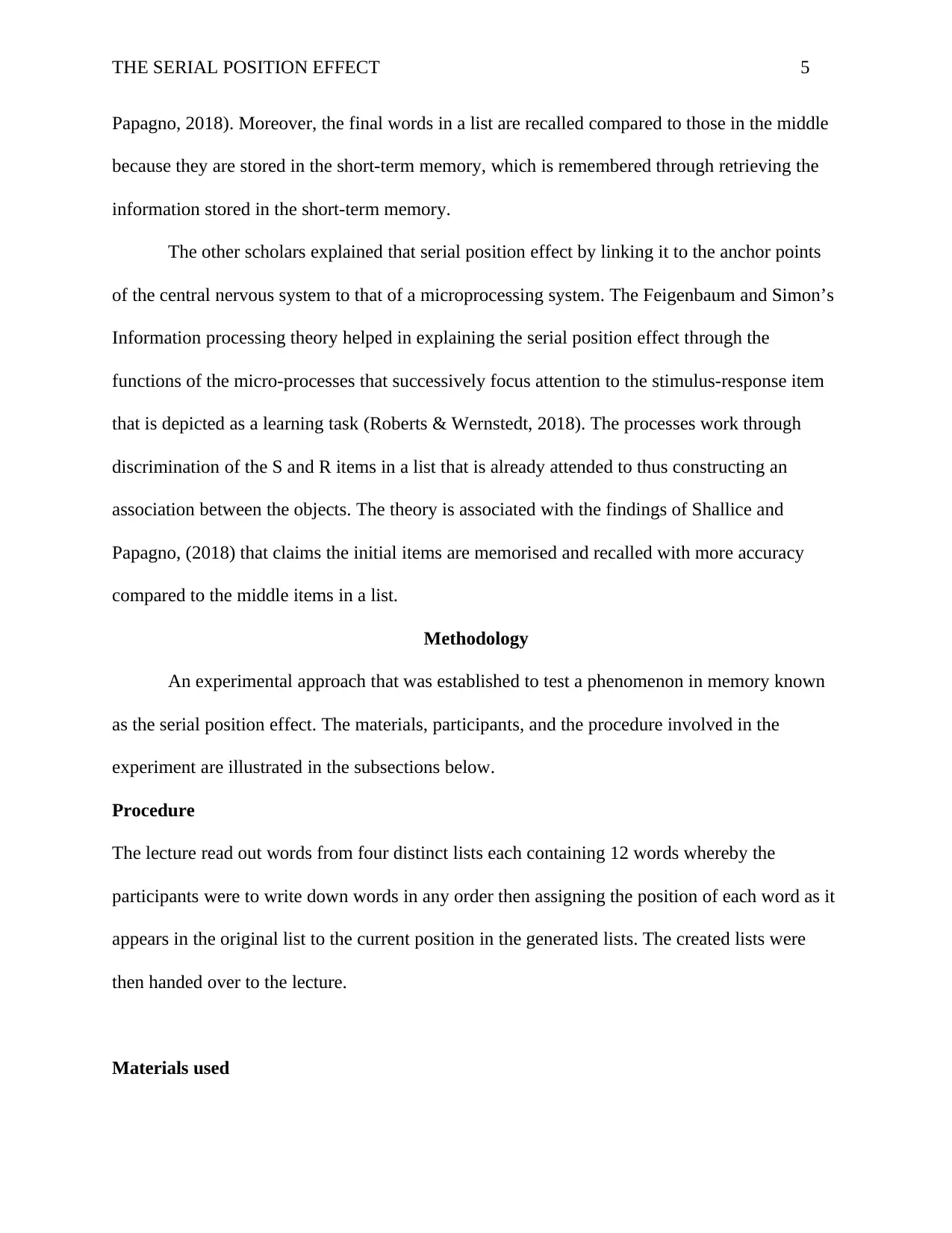
THE SERIAL POSITION EFFECT 5
Papagno, 2018). Moreover, the final words in a list are recalled compared to those in the middle
because they are stored in the short-term memory, which is remembered through retrieving the
information stored in the short-term memory.
The other scholars explained that serial position effect by linking it to the anchor points
of the central nervous system to that of a microprocessing system. The Feigenbaum and Simon’s
Information processing theory helped in explaining the serial position effect through the
functions of the micro-processes that successively focus attention to the stimulus-response item
that is depicted as a learning task (Roberts & Wernstedt, 2018). The processes work through
discrimination of the S and R items in a list that is already attended to thus constructing an
association between the objects. The theory is associated with the findings of Shallice and
Papagno, (2018) that claims the initial items are memorised and recalled with more accuracy
compared to the middle items in a list.
Methodology
An experimental approach that was established to test a phenomenon in memory known
as the serial position effect. The materials, participants, and the procedure involved in the
experiment are illustrated in the subsections below.
Procedure
The lecture read out words from four distinct lists each containing 12 words whereby the
participants were to write down words in any order then assigning the position of each word as it
appears in the original list to the current position in the generated lists. The created lists were
then handed over to the lecture.
Materials used
Papagno, 2018). Moreover, the final words in a list are recalled compared to those in the middle
because they are stored in the short-term memory, which is remembered through retrieving the
information stored in the short-term memory.
The other scholars explained that serial position effect by linking it to the anchor points
of the central nervous system to that of a microprocessing system. The Feigenbaum and Simon’s
Information processing theory helped in explaining the serial position effect through the
functions of the micro-processes that successively focus attention to the stimulus-response item
that is depicted as a learning task (Roberts & Wernstedt, 2018). The processes work through
discrimination of the S and R items in a list that is already attended to thus constructing an
association between the objects. The theory is associated with the findings of Shallice and
Papagno, (2018) that claims the initial items are memorised and recalled with more accuracy
compared to the middle items in a list.
Methodology
An experimental approach that was established to test a phenomenon in memory known
as the serial position effect. The materials, participants, and the procedure involved in the
experiment are illustrated in the subsections below.
Procedure
The lecture read out words from four distinct lists each containing 12 words whereby the
participants were to write down words in any order then assigning the position of each word as it
appears in the original list to the current position in the generated lists. The created lists were
then handed over to the lecture.
Materials used
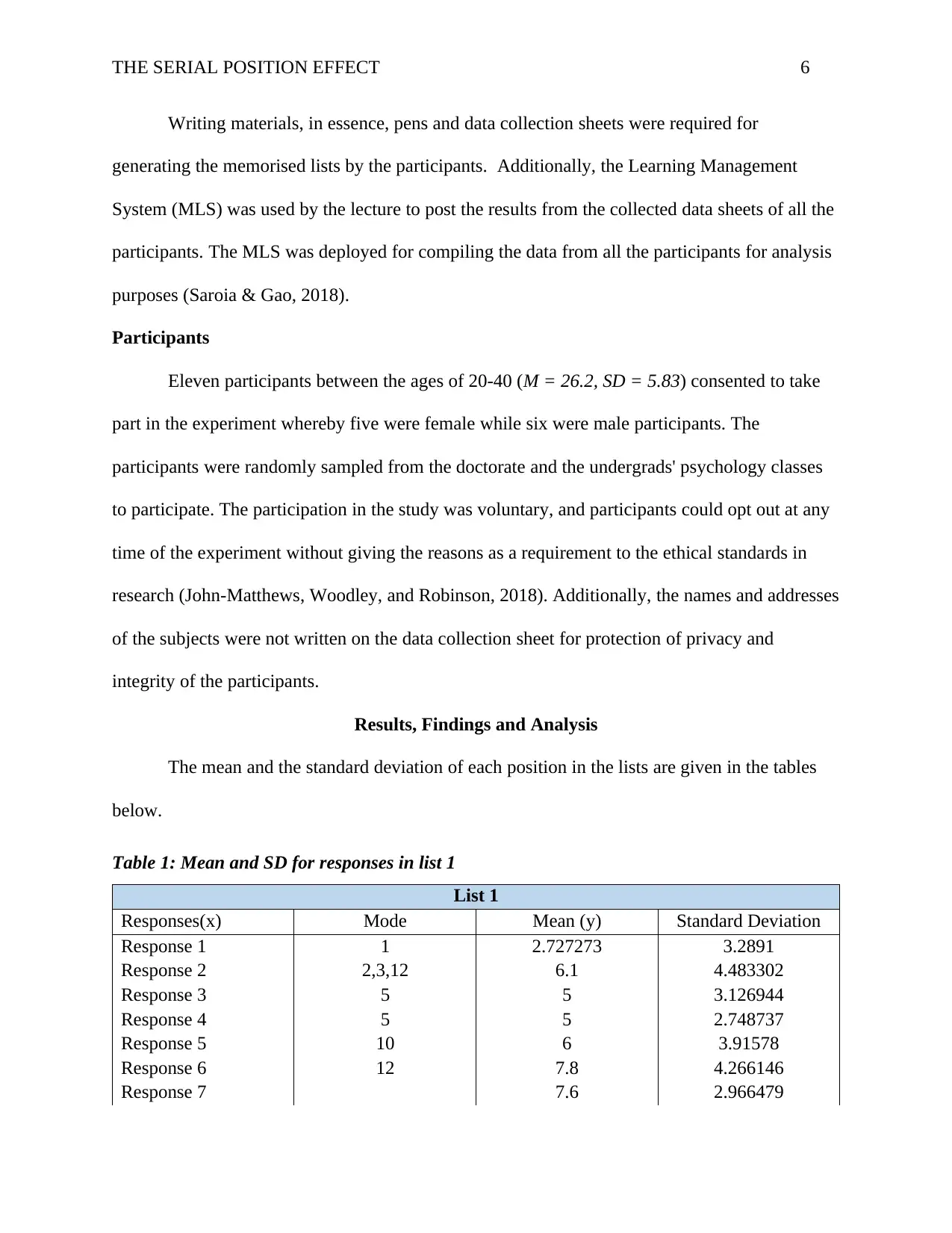
THE SERIAL POSITION EFFECT 6
Writing materials, in essence, pens and data collection sheets were required for
generating the memorised lists by the participants. Additionally, the Learning Management
System (MLS) was used by the lecture to post the results from the collected data sheets of all the
participants. The MLS was deployed for compiling the data from all the participants for analysis
purposes (Saroia & Gao, 2018).
Participants
Eleven participants between the ages of 20-40 (M = 26.2, SD = 5.83) consented to take
part in the experiment whereby five were female while six were male participants. The
participants were randomly sampled from the doctorate and the undergrads' psychology classes
to participate. The participation in the study was voluntary, and participants could opt out at any
time of the experiment without giving the reasons as a requirement to the ethical standards in
research (John-Matthews, Woodley, and Robinson, 2018). Additionally, the names and addresses
of the subjects were not written on the data collection sheet for protection of privacy and
integrity of the participants.
Results, Findings and Analysis
The mean and the standard deviation of each position in the lists are given in the tables
below.
Table 1: Mean and SD for responses in list 1
List 1
Responses(x) Mode Mean (y) Standard Deviation
Response 1 1 2.727273 3.2891
Response 2 2,3,12 6.1 4.483302
Response 3 5 5 3.126944
Response 4 5 5 2.748737
Response 5 10 6 3.91578
Response 6 12 7.8 4.266146
Response 7 7.6 2.966479
Writing materials, in essence, pens and data collection sheets were required for
generating the memorised lists by the participants. Additionally, the Learning Management
System (MLS) was used by the lecture to post the results from the collected data sheets of all the
participants. The MLS was deployed for compiling the data from all the participants for analysis
purposes (Saroia & Gao, 2018).
Participants
Eleven participants between the ages of 20-40 (M = 26.2, SD = 5.83) consented to take
part in the experiment whereby five were female while six were male participants. The
participants were randomly sampled from the doctorate and the undergrads' psychology classes
to participate. The participation in the study was voluntary, and participants could opt out at any
time of the experiment without giving the reasons as a requirement to the ethical standards in
research (John-Matthews, Woodley, and Robinson, 2018). Additionally, the names and addresses
of the subjects were not written on the data collection sheet for protection of privacy and
integrity of the participants.
Results, Findings and Analysis
The mean and the standard deviation of each position in the lists are given in the tables
below.
Table 1: Mean and SD for responses in list 1
List 1
Responses(x) Mode Mean (y) Standard Deviation
Response 1 1 2.727273 3.2891
Response 2 2,3,12 6.1 4.483302
Response 3 5 5 3.126944
Response 4 5 5 2.748737
Response 5 10 6 3.91578
Response 6 12 7.8 4.266146
Response 7 7.6 2.966479
⊘ This is a preview!⊘
Do you want full access?
Subscribe today to unlock all pages.

Trusted by 1+ million students worldwide

THE SERIAL POSITION EFFECT 7
Response 8 5.5 0.707107
Response 9 12
Response 10
Response 11
Response 12
From the table, the mean and the standard deviation could only be obtained among the
participants for a maximum of eight responses where only a single participant had up to a ninth
response in their list of words. None of the subjects remembered all the words in the first list.
Table 2: Mean and SD for responses in list 2
List 2
Responses(x) Mode Mean (y) Standard Deviation
Response 1 1 5.090909 4.570657
Response 2 2,11 5.3 4.217688
Response 3 12 7.6 4.452215
Response 4 10 7.5 4.196559
Response 5 6,11,12 8.5 3.625308
Response 6 2 5.714286 4.309458
Response 7 5.6 3.911521
Response 8 3 5.090909 4.570657
Response 9
Response 10
Response 11
Response 12
From the table, it can be depicted that the mean and the standard deviation could only be
obtained up to the eighth response as no subject recalled all the words from the second list.
Table 3: Mean and SD for responses in list 3
List 3
Responses(x) Mode Mean (y) Standard Deviation
Response 8 5.5 0.707107
Response 9 12
Response 10
Response 11
Response 12
From the table, the mean and the standard deviation could only be obtained among the
participants for a maximum of eight responses where only a single participant had up to a ninth
response in their list of words. None of the subjects remembered all the words in the first list.
Table 2: Mean and SD for responses in list 2
List 2
Responses(x) Mode Mean (y) Standard Deviation
Response 1 1 5.090909 4.570657
Response 2 2,11 5.3 4.217688
Response 3 12 7.6 4.452215
Response 4 10 7.5 4.196559
Response 5 6,11,12 8.5 3.625308
Response 6 2 5.714286 4.309458
Response 7 5.6 3.911521
Response 8 3 5.090909 4.570657
Response 9
Response 10
Response 11
Response 12
From the table, it can be depicted that the mean and the standard deviation could only be
obtained up to the eighth response as no subject recalled all the words from the second list.
Table 3: Mean and SD for responses in list 3
List 3
Responses(x) Mode Mean (y) Standard Deviation
Paraphrase This Document
Need a fresh take? Get an instant paraphrase of this document with our AI Paraphraser
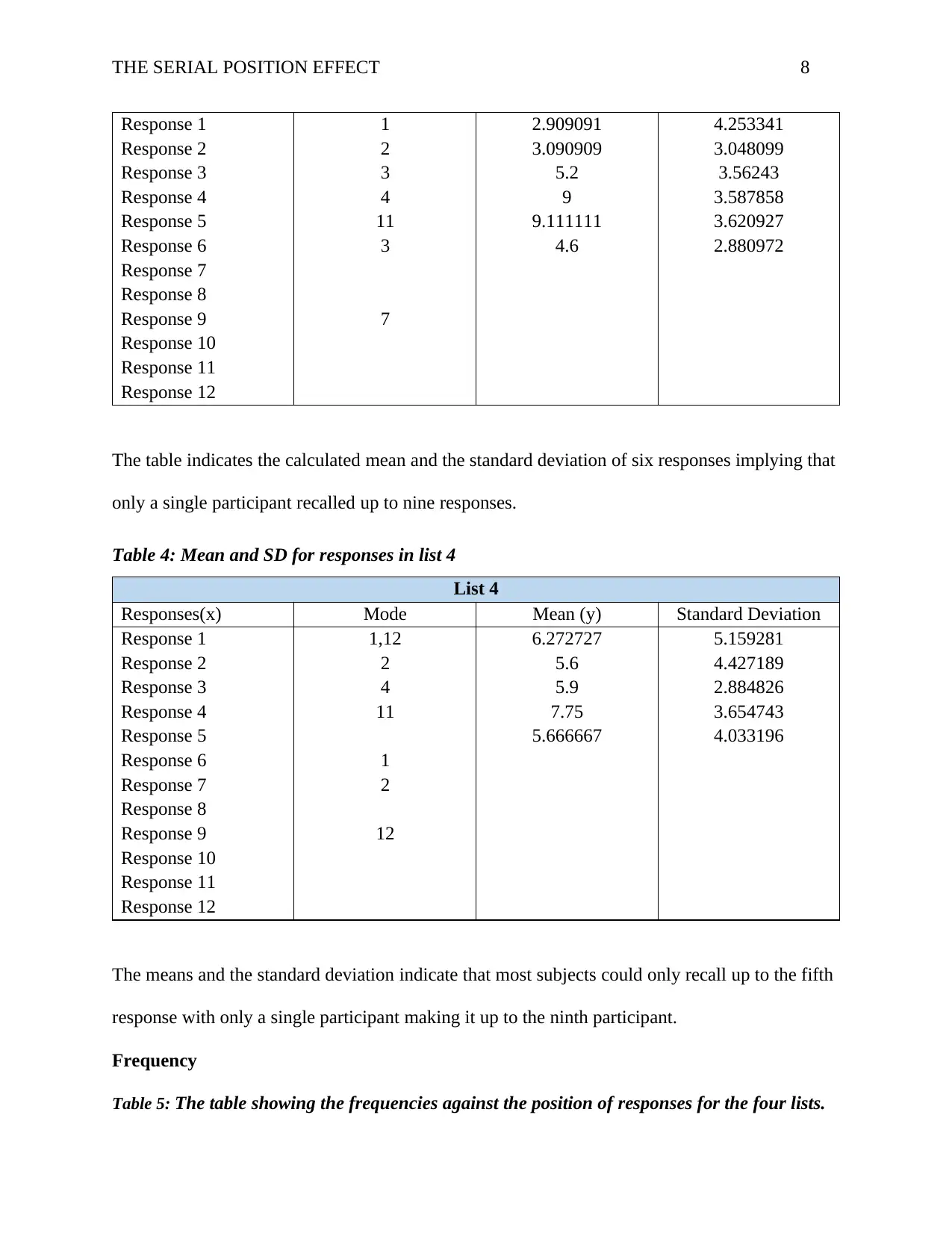
THE SERIAL POSITION EFFECT 8
Response 1 1 2.909091 4.253341
Response 2 2 3.090909 3.048099
Response 3 3 5.2 3.56243
Response 4 4 9 3.587858
Response 5 11 9.111111 3.620927
Response 6 3 4.6 2.880972
Response 7
Response 8
Response 9 7
Response 10
Response 11
Response 12
The table indicates the calculated mean and the standard deviation of six responses implying that
only a single participant recalled up to nine responses.
Table 4: Mean and SD for responses in list 4
List 4
Responses(x) Mode Mean (y) Standard Deviation
Response 1 1,12 6.272727 5.159281
Response 2 2 5.6 4.427189
Response 3 4 5.9 2.884826
Response 4 11 7.75 3.654743
Response 5 5.666667 4.033196
Response 6 1
Response 7 2
Response 8
Response 9 12
Response 10
Response 11
Response 12
The means and the standard deviation indicate that most subjects could only recall up to the fifth
response with only a single participant making it up to the ninth participant.
Frequency
Table 5: The table showing the frequencies against the position of responses for the four lists.
Response 1 1 2.909091 4.253341
Response 2 2 3.090909 3.048099
Response 3 3 5.2 3.56243
Response 4 4 9 3.587858
Response 5 11 9.111111 3.620927
Response 6 3 4.6 2.880972
Response 7
Response 8
Response 9 7
Response 10
Response 11
Response 12
The table indicates the calculated mean and the standard deviation of six responses implying that
only a single participant recalled up to nine responses.
Table 4: Mean and SD for responses in list 4
List 4
Responses(x) Mode Mean (y) Standard Deviation
Response 1 1,12 6.272727 5.159281
Response 2 2 5.6 4.427189
Response 3 4 5.9 2.884826
Response 4 11 7.75 3.654743
Response 5 5.666667 4.033196
Response 6 1
Response 7 2
Response 8
Response 9 12
Response 10
Response 11
Response 12
The means and the standard deviation indicate that most subjects could only recall up to the fifth
response with only a single participant making it up to the ninth participant.
Frequency
Table 5: The table showing the frequencies against the position of responses for the four lists.
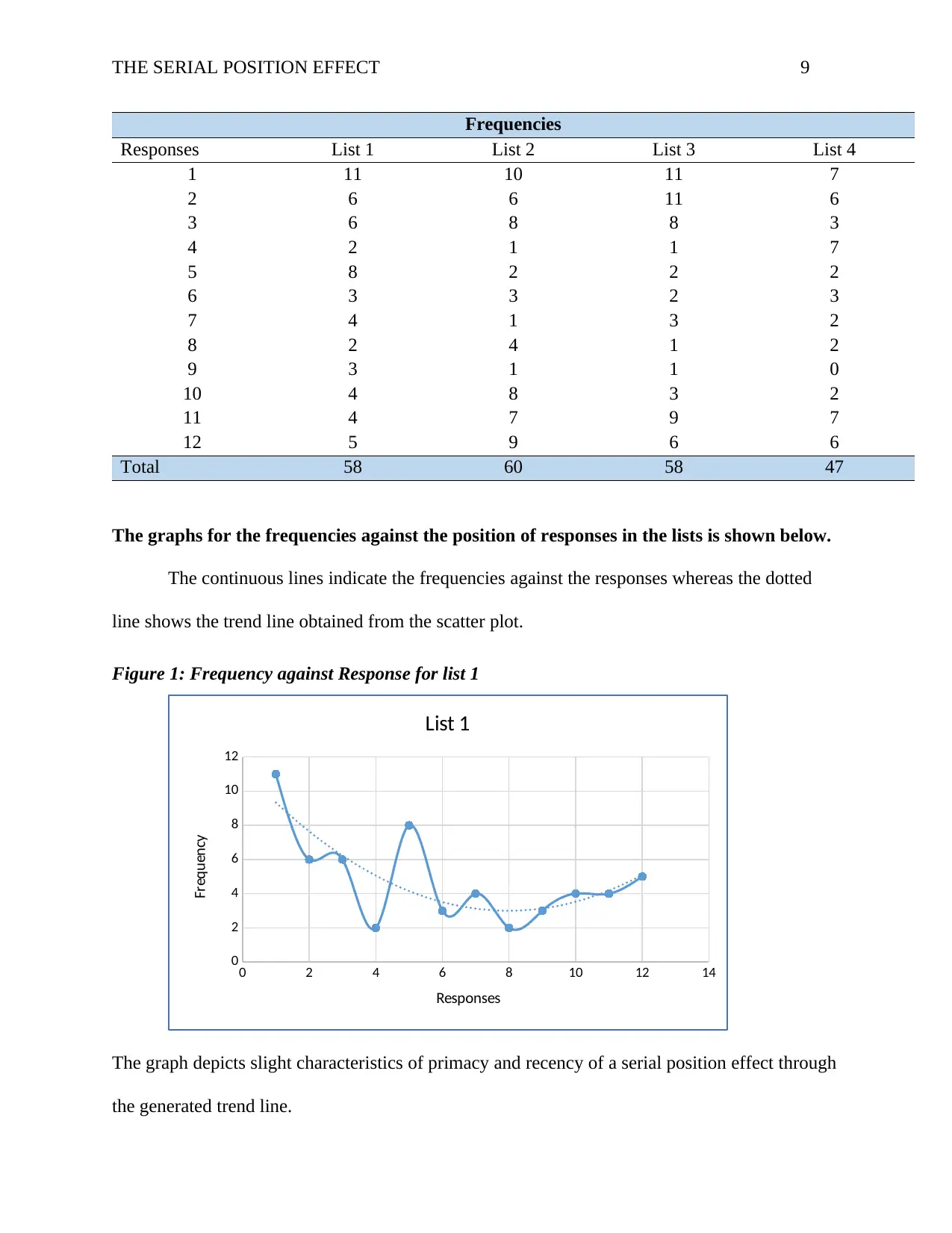
THE SERIAL POSITION EFFECT 9
Frequencies
Responses List 1 List 2 List 3 List 4
1 11 10 11 7
2 6 6 11 6
3 6 8 8 3
4 2 1 1 7
5 8 2 2 2
6 3 3 2 3
7 4 1 3 2
8 2 4 1 2
9 3 1 1 0
10 4 8 3 2
11 4 7 9 7
12 5 9 6 6
Total 58 60 58 47
The graphs for the frequencies against the position of responses in the lists is shown below.
The continuous lines indicate the frequencies against the responses whereas the dotted
line shows the trend line obtained from the scatter plot.
Figure 1: Frequency against Response for list 1
0 2 4 6 8 10 12 14
0
2
4
6
8
10
12
List 1
Responses
Frequency
The graph depicts slight characteristics of primacy and recency of a serial position effect through
the generated trend line.
Frequencies
Responses List 1 List 2 List 3 List 4
1 11 10 11 7
2 6 6 11 6
3 6 8 8 3
4 2 1 1 7
5 8 2 2 2
6 3 3 2 3
7 4 1 3 2
8 2 4 1 2
9 3 1 1 0
10 4 8 3 2
11 4 7 9 7
12 5 9 6 6
Total 58 60 58 47
The graphs for the frequencies against the position of responses in the lists is shown below.
The continuous lines indicate the frequencies against the responses whereas the dotted
line shows the trend line obtained from the scatter plot.
Figure 1: Frequency against Response for list 1
0 2 4 6 8 10 12 14
0
2
4
6
8
10
12
List 1
Responses
Frequency
The graph depicts slight characteristics of primacy and recency of a serial position effect through
the generated trend line.
⊘ This is a preview!⊘
Do you want full access?
Subscribe today to unlock all pages.

Trusted by 1+ million students worldwide
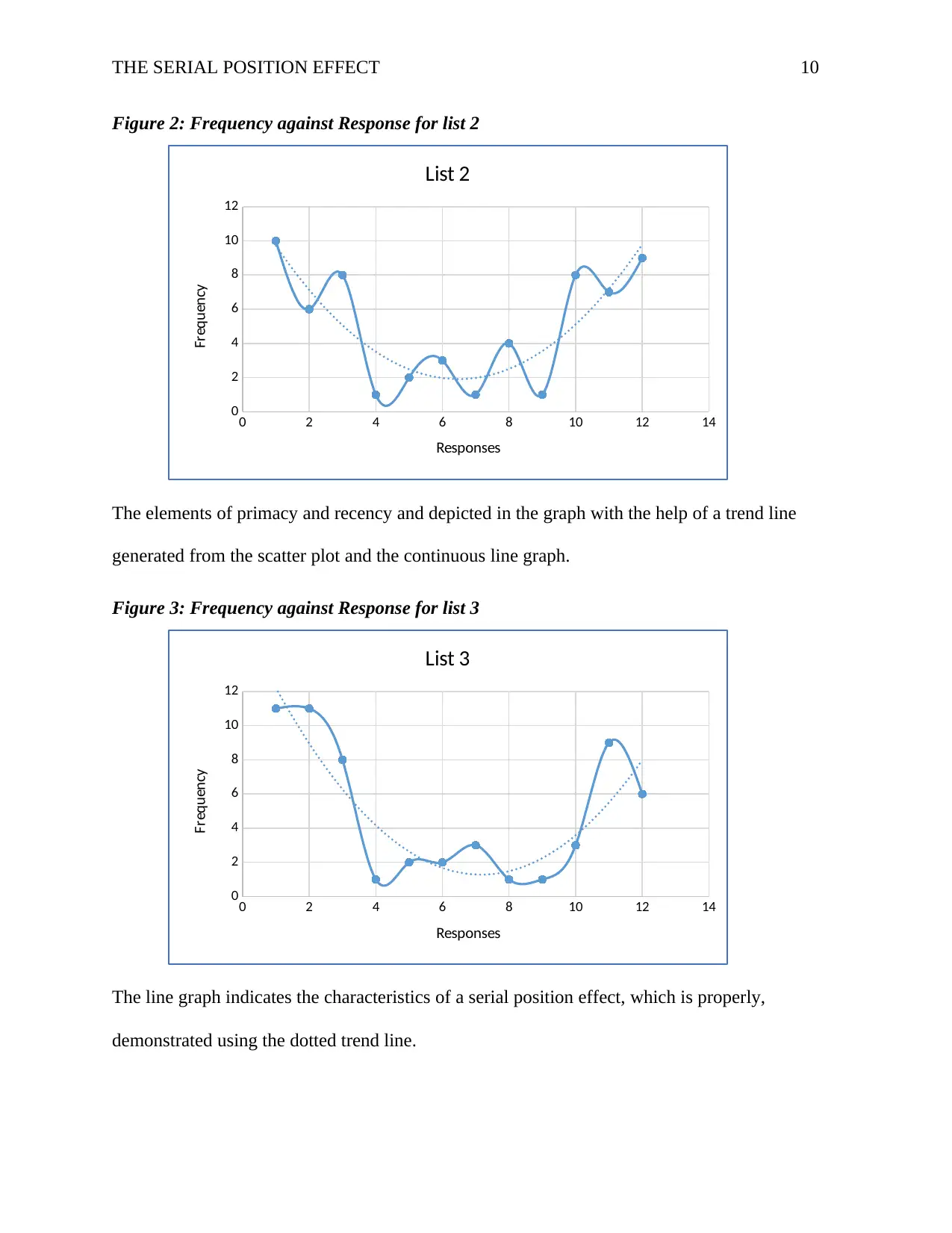
THE SERIAL POSITION EFFECT 10
Figure 2: Frequency against Response for list 2
0 2 4 6 8 10 12 14
0
2
4
6
8
10
12
List 2
Responses
Frequency
The elements of primacy and recency and depicted in the graph with the help of a trend line
generated from the scatter plot and the continuous line graph.
Figure 3: Frequency against Response for list 3
0 2 4 6 8 10 12 14
0
2
4
6
8
10
12
List 3
Responses
Frequency
The line graph indicates the characteristics of a serial position effect, which is properly,
demonstrated using the dotted trend line.
Figure 2: Frequency against Response for list 2
0 2 4 6 8 10 12 14
0
2
4
6
8
10
12
List 2
Responses
Frequency
The elements of primacy and recency and depicted in the graph with the help of a trend line
generated from the scatter plot and the continuous line graph.
Figure 3: Frequency against Response for list 3
0 2 4 6 8 10 12 14
0
2
4
6
8
10
12
List 3
Responses
Frequency
The line graph indicates the characteristics of a serial position effect, which is properly,
demonstrated using the dotted trend line.
Paraphrase This Document
Need a fresh take? Get an instant paraphrase of this document with our AI Paraphraser
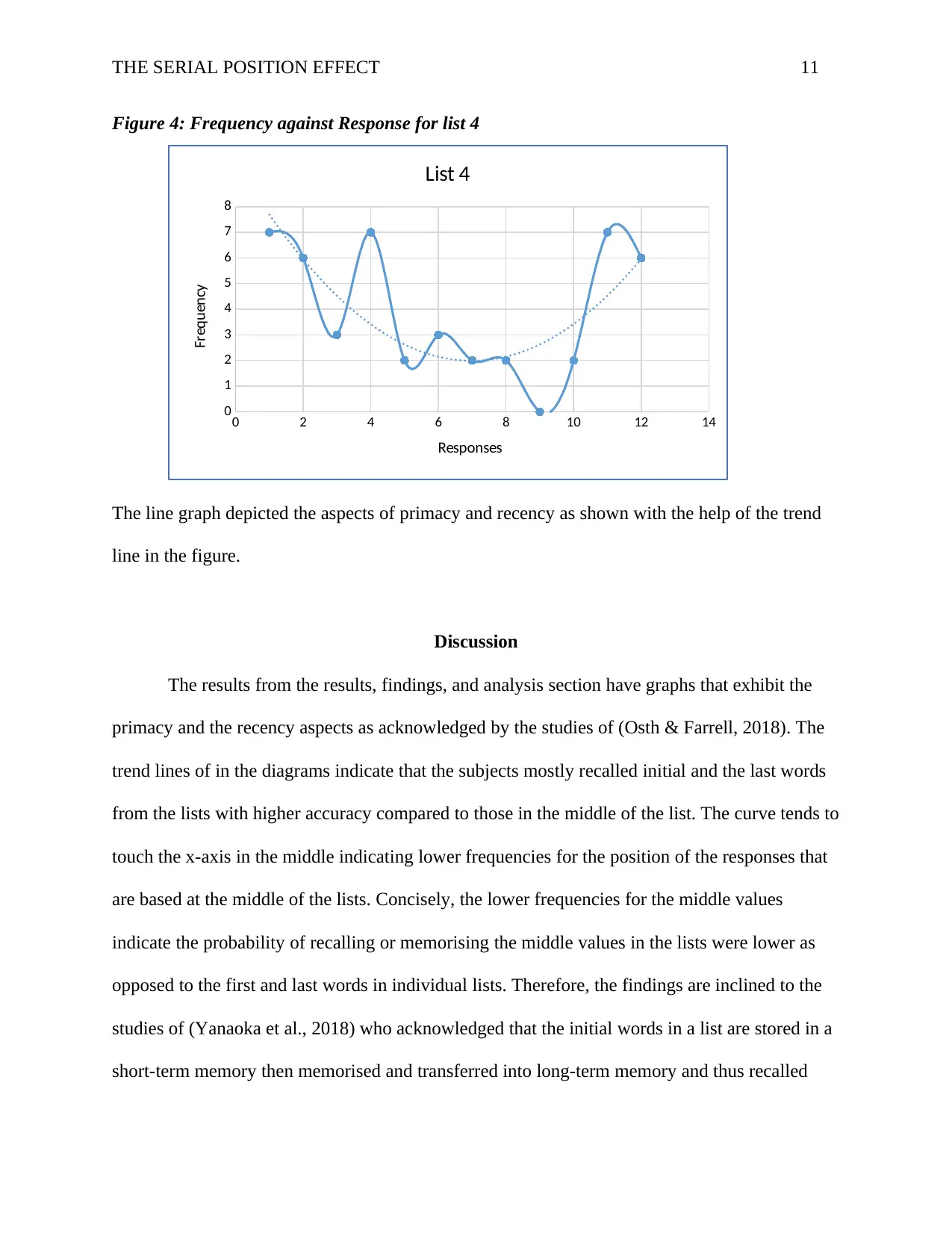
THE SERIAL POSITION EFFECT 11
Figure 4: Frequency against Response for list 4
0 2 4 6 8 10 12 14
0
1
2
3
4
5
6
7
8
List 4
Responses
Frequency
The line graph depicted the aspects of primacy and recency as shown with the help of the trend
line in the figure.
Discussion
The results from the results, findings, and analysis section have graphs that exhibit the
primacy and the recency aspects as acknowledged by the studies of (Osth & Farrell, 2018). The
trend lines of in the diagrams indicate that the subjects mostly recalled initial and the last words
from the lists with higher accuracy compared to those in the middle of the list. The curve tends to
touch the x-axis in the middle indicating lower frequencies for the position of the responses that
are based at the middle of the lists. Concisely, the lower frequencies for the middle values
indicate the probability of recalling or memorising the middle values in the lists were lower as
opposed to the first and last words in individual lists. Therefore, the findings are inclined to the
studies of (Yanaoka et al., 2018) who acknowledged that the initial words in a list are stored in a
short-term memory then memorised and transferred into long-term memory and thus recalled
Figure 4: Frequency against Response for list 4
0 2 4 6 8 10 12 14
0
1
2
3
4
5
6
7
8
List 4
Responses
Frequency
The line graph depicted the aspects of primacy and recency as shown with the help of the trend
line in the figure.
Discussion
The results from the results, findings, and analysis section have graphs that exhibit the
primacy and the recency aspects as acknowledged by the studies of (Osth & Farrell, 2018). The
trend lines of in the diagrams indicate that the subjects mostly recalled initial and the last words
from the lists with higher accuracy compared to those in the middle of the list. The curve tends to
touch the x-axis in the middle indicating lower frequencies for the position of the responses that
are based at the middle of the lists. Concisely, the lower frequencies for the middle values
indicate the probability of recalling or memorising the middle values in the lists were lower as
opposed to the first and last words in individual lists. Therefore, the findings are inclined to the
studies of (Yanaoka et al., 2018) who acknowledged that the initial words in a list are stored in a
short-term memory then memorised and transferred into long-term memory and thus recalled
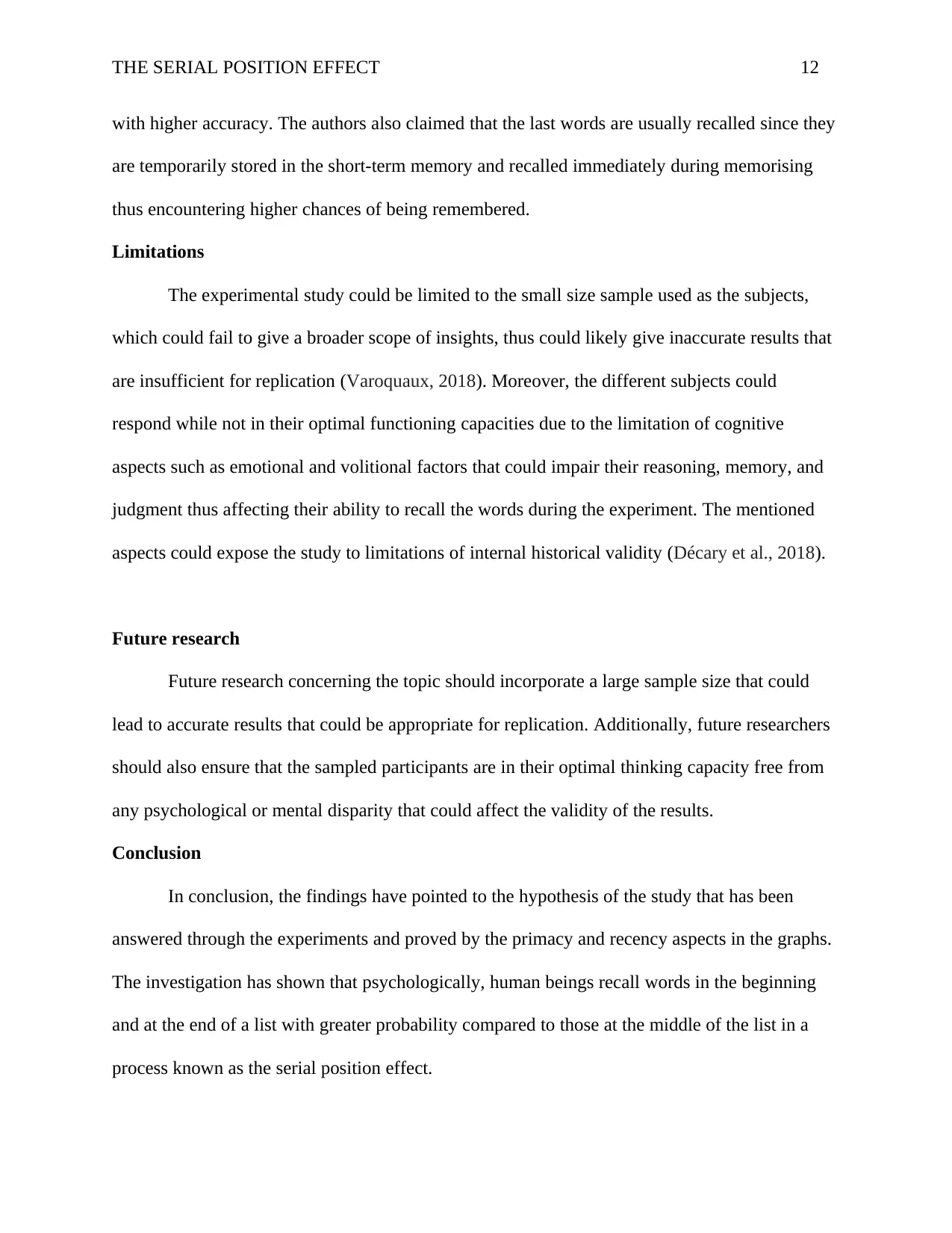
THE SERIAL POSITION EFFECT 12
with higher accuracy. The authors also claimed that the last words are usually recalled since they
are temporarily stored in the short-term memory and recalled immediately during memorising
thus encountering higher chances of being remembered.
Limitations
The experimental study could be limited to the small size sample used as the subjects,
which could fail to give a broader scope of insights, thus could likely give inaccurate results that
are insufficient for replication (Varoquaux, 2018). Moreover, the different subjects could
respond while not in their optimal functioning capacities due to the limitation of cognitive
aspects such as emotional and volitional factors that could impair their reasoning, memory, and
judgment thus affecting their ability to recall the words during the experiment. The mentioned
aspects could expose the study to limitations of internal historical validity (Décary et al., 2018).
Future research
Future research concerning the topic should incorporate a large sample size that could
lead to accurate results that could be appropriate for replication. Additionally, future researchers
should also ensure that the sampled participants are in their optimal thinking capacity free from
any psychological or mental disparity that could affect the validity of the results.
Conclusion
In conclusion, the findings have pointed to the hypothesis of the study that has been
answered through the experiments and proved by the primacy and recency aspects in the graphs.
The investigation has shown that psychologically, human beings recall words in the beginning
and at the end of a list with greater probability compared to those at the middle of the list in a
process known as the serial position effect.
with higher accuracy. The authors also claimed that the last words are usually recalled since they
are temporarily stored in the short-term memory and recalled immediately during memorising
thus encountering higher chances of being remembered.
Limitations
The experimental study could be limited to the small size sample used as the subjects,
which could fail to give a broader scope of insights, thus could likely give inaccurate results that
are insufficient for replication (Varoquaux, 2018). Moreover, the different subjects could
respond while not in their optimal functioning capacities due to the limitation of cognitive
aspects such as emotional and volitional factors that could impair their reasoning, memory, and
judgment thus affecting their ability to recall the words during the experiment. The mentioned
aspects could expose the study to limitations of internal historical validity (Décary et al., 2018).
Future research
Future research concerning the topic should incorporate a large sample size that could
lead to accurate results that could be appropriate for replication. Additionally, future researchers
should also ensure that the sampled participants are in their optimal thinking capacity free from
any psychological or mental disparity that could affect the validity of the results.
Conclusion
In conclusion, the findings have pointed to the hypothesis of the study that has been
answered through the experiments and proved by the primacy and recency aspects in the graphs.
The investigation has shown that psychologically, human beings recall words in the beginning
and at the end of a list with greater probability compared to those at the middle of the list in a
process known as the serial position effect.
⊘ This is a preview!⊘
Do you want full access?
Subscribe today to unlock all pages.

Trusted by 1+ million students worldwide
1 out of 15
Your All-in-One AI-Powered Toolkit for Academic Success.
+13062052269
info@desklib.com
Available 24*7 on WhatsApp / Email
![[object Object]](/_next/static/media/star-bottom.7253800d.svg)
Unlock your academic potential
Copyright © 2020–2025 A2Z Services. All Rights Reserved. Developed and managed by ZUCOL.


